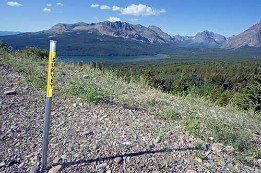3 THINGS DEVELOPERS SHOULD KNOW ABOUT CONSTRUCTION STAKING
- By Admin
- •
- 24 Jan, 2018
- •

Construction staking is a vital step in seeing your project through from planning to completion. What exactly is construction staking? This short guide includes some facts you should know about the process.
CONSTRUCTION STAKING
HELPS CONTRACTORS
Whether you're developing a property from scratch or adding new infrastructure to an existing facility, construction staking is performed by trained personnel on your property site. Pegs, stakes, and other markers are used to inform contractors about details of the work to be done. The types of construction staking required will vary depending on the type of property under construction.
For a new retail development, construction markers might show the:
- Property control points
- Boundary markers
- Pipeline locations
- Utility burial sites
- Driveway and parking-area dimensions
- Slope of future hills or terraced areas
The outline of the building and other new construction details will also be marked off by construction staking. Marking the precise dimensions of the building helps in the planning of material drop-offs, construction-equipment parking, and measuring of materials on site.
For a project in an active gas or oil field, additional details are staked out. Construction stakes and markers inform workers about accessing wells, ponds and derricks. Stakes show where compressor stations and gas-processing sites are. Construction stakes in gas fields may also indicate the surface disturbance limits and the property boundaries.
CONSTRUCTION STAKING USES SEVERAL TYPES OF MARKERS
Construction markers vary from location to location. Some markers are industry-specific, while others are generic and used in all types of construction and roadwork projects.
Some of the common wooden stakes and markers include:
Long and Short Stakes
These 8-inch- or 16-inch-long stakes measure 1 1/2 inches by 3/4 inch in width. A point at the end makes them easy to drive into the ground. Stakes are placed in the ground next to a key marker (or hub) and facing it. Writing on the stakes conveys vital information about the adjacent hub to workers and contractors.
Hub Marker
This is a 1 1/2-inch square peg with a point at the bottom for driving in the sub-grade or other areas. A hub is one foot long and is used for important control points. Nearby stakes should offer details on the hub. Two or three stakes may be placed near a control point to accent the location.
Guinea Marker
Guinea markers resemble fat pencils. These 3/4-inch round markers are used in 6-inch or 8-inch lengths to show the locations of non-control points. Informational stakes are used to tell workers about the guinea marker.
Wooden stakes may be spray-painted in bright colors to make them stand out on the job site. Ribbons or tape pieces are also attached to stakes. Tape pieces in various colors and color combinations are used to show the location of utilities, reference points, benchmarks, and other key site features. Metal pins, rods, and other markers are used in construction staking as well.
CONSTRUCTION STAKING DEPENDS ON ACCURACY
Contractors, builders, pavers, and others rely on the accuracy of construction staking to perform their jobs. When the staking is reliable, each part of the project comes together and fits with the whole.
In order for the markings on a site to be as accurate as possible, project engineers and managers must provide as much detail as possible to the team doing the construction staking. It's better to give far too much detail in your site plans than to give too little detail.
For construction staking in Nevada, the DOT recommends you compile the following plans as needed for your construction-staking crew:
- Construction alignment book
- Structure book for bridges and culverts
- Grade book for setting grade stakes
You must also provide slope stake data, giving the percent of grade, vertical-curve, shoulder distance and other pertinent data when creating new land contours. In some locations, you can only have utilities staked out after all streets, sidewalks, roads, and other easements are cleared, cut, and finished to subgrade.
Contact Arnett & Associates, Inc. to schedule your construction staking for residential and commercial projects. We also perform boundary surveys and help you qualify for a Building Setback Certificate when necessary.
Featured Reviews
⋆⋆⋆⋆⋆
Positive: Professionalism, Quality, Responsiveness, Value
Ken and his group are awesome.
They answer the phone and are super easy to work with.
⋆⋆⋆⋆⋆
The owner, Ken, was very responsive to our needs and questions. We would highly recommend him and his team.
-Craig F
120 Country Club Dr.
Suite 13
Incline Village, NV 89451
Main: 775-831-8618
Fax: 775-831-8534
Email: ken@arnettconsultants.com
South Tahoe: 530-541-3006
Truckee: 530-587-0622
Business Hours:
Mon – Fri: 8:30 a.m. – 5 p.m.
Saturday: Available by Appointment




